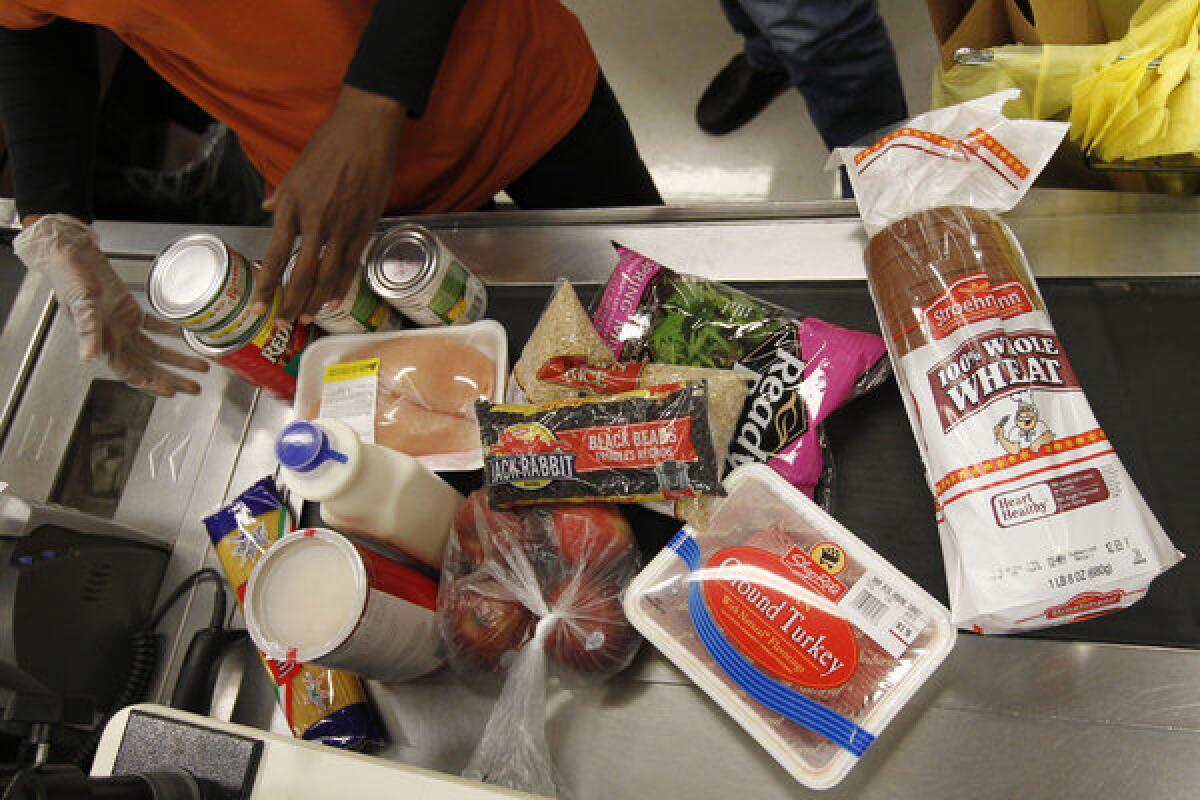President Scrooge’s Christmas gift to millions of poor Americans: A cut to their small food stipend

- Share via
In a rare moment of bipartisanship, Congress rejected President Trump’s efforts on last year’s farm bill to impose new food stamp restrictions that would have cut benefits for more than a million needy people. So Trump decided to pursue the changes through executive action. On Wednesday, the U.S. Department of Agriculture finalized the first of three new regulatory changes to food stamps, formally known as the Supplemental Nutrition Assistance Program, just in time for the holidays. And boy, it is just as punitive and miserly as we feared. Bah, humbug!
Currently, adults without kids who are 18 to 49 years old and not mentally or physically impaired are limited to three months of SNAP benefits every three years unless they are working at least 20 hours a week or enrolled in a government-sponsored training program. But states may waive the work requirement in counties that have endured significantly higher than average unemployment rates for two years or more. The new rule arbitrarily bars such waivers in counties where unemployment is less than 6%, no matter how much higher their rate is than the national average. The USDA expects the change to cut off aid to 688,000 low-income Americans.
But wait — it gets worse.
Two new SNAP rules waiting to be finalized would tighten eligibility requirements, reducing the food stamp rolls even further, and cut monthly benefits for some individuals and families. One of the changes would stop states from using “categorical eligibility” to qualify SNAP recipients, which reduces paperwork and allows states to increase the amount of assets or revenue an individual or family can have (up to 200% of the federal poverty level) and still qualify for benefits. The other would tinker with how people’s utility bills affect their food stamp allocations, with the net effect of lowering benefits for some recipients and raising them for others (though it will do more of the former than the latter, according to an Urban Institute analysis). It’s not clear what these changes to benefits accomplishes other than saving the government some money.
But the tinkering carries potentially great costs to the poorest Americans. Collectively, the changes could impact 3.7 million low-income people, and not only able-bodied adults without kids. The Urban Institute estimates that as many as half a million families with children could lose SNAP eligibility. Too bad for all those Tiny Tims out there.
If this were about necessary belt-tightening, then it might be easier to swallow. But the administration justifies the new food stamp rules as a sort of tough-love policy that helps poor people help themselves. “This is about restoring the original intent of food stamps … moving more able-bodied Americans to self-sufficiency,” Agriculture Secretary Sonny Perdue told reporters last week. He and other Trumpsters view government relief programs as snares that trap people in a cycle of poverty.
There’s little evidence, though, that the administration is focused on making anti-poverty programs more effective, as opposed to simply cutting their cost. And SNAP is penurious as it is; the average monthly SNAP benefit is $127. To be eligible, applicants’ income must not exceed a paltry 130% of the poverty line, the equivalent of $2,213 a month or less for a family of three. Restricting access to this meager and temporary food stipend is unlikely to help anyone lift themselves out of poverty and may well force more people over the edge of the economic cliff on which they are balancing. With the country enduring a horrendous homeless crisis, this is absolutely the wrong move.
Furthermore, the argument that the economy is so strong that anyone can find a good job if forced to do so glosses over the fact that the recovery didn’t reach every industry in every corner of the country. Despite extremely low national unemployment levels, it may still be difficult, if not impossible, for some blue-collar workers to find jobs for which they are qualified within their home state.
Ultimately, the government doesn’t need to do anything to reduce reliance on SNAP. Participation has naturally declined as the economy has improved over the last decade, as expected for a safety net program. In 2013, SNAP had 48 million participants. As of April, the figure was down to 36 million — with no action taken by the government. But reason and numbers don’t seem to matter much to the administration as it rams through changes that even Congress thought went too far. You’re a mean one, Mr. Trump.
More to Read
A cure for the common opinion
Get thought-provoking perspectives with our weekly newsletter.
You may occasionally receive promotional content from the Los Angeles Times.






